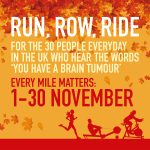Jane was diagnosed with a Meningioma in 2019, and after a twelve-and-a-half-hour surgery was left struggling with the physical side effects. Jane has shared her story from diagnosis to present and tells us how finding brainstrust has helped her through difficult times.
Content warning: Please be advised, Jane’s story contains references to abuse and suicide. It’s important to us that we share the challenges our community face, but this story may be a challenging read and not for everyone.
When I asked Jane why she wanted to tell her story, she said, “because I don’t want people to suffer the way I have suffered.”
Jane has had what has felt like a lifetime of suffering. She’s endured a tumultuous, challenging existence for as long as she can remember. As a young girl, she was sexually abused for nearly ten years, and as a young woman, found herself caught in the endless cycle of an abusive relationship.
But when I asked Jane to introduce herself, she said, “Hello, I’m Jane. This is my dog Boise. He’s a fifteen-month-old puppy. He will be boisterous with you, but please have some patience with us both. He’s new to me and I’ve had recent brain tumour removal.”
Receiving her diagnosis
Despite the challenging life she has led, her recent years have been shaped by two main challenges — the loss of her ten-and-a-half stone German Shepherd companion, aptly named Bear, and the resection of a left-hemisphere meningioma.
In 2019, she began to notice she was having difficulty swallowing. She went to see an ear, nose, and throat specialist. After taking one scan, they asked Jane to go to the other side of the building for another scan.
“The cancer unit?” She asked.
“The scanners are better on that side.” He replied, tight-lipped.
“What do you think you found?” She asked, increasingly worried.
“Let’s just take a look first.”
“No. I want to know what you think you found.” Jane said, adamant.
“We think we found a brain tumour.”
Shortly after being diagnosed with a meningioma of her left hemisphere, the world went into lockdown. Jane avoided researching her diagnosis, knowing that whatever she found would likely do nothing but terrify her even more.
It was all hard to make sense of. She was left feeling angry. I felt very angry because I was a battered woman for a long time. And I thought, is it that, that’s done it? You know? Years later… No fairness in the world.”
A couple of years went by where the tumour’s growth was monitored. But then, her balance had become so poor that she fell over in her garden. She was unable to get up on her own and was terrified.
She was told it was time to try and resect the tumour.
Surgery and the road to recovery
On August 5th, 2021 she went in for what would become a twelve-and-a-half hour surgery.
Early recovery was challenging. During the surgery, she had choked on her own vomit and had to be resuscitated. And when she woke up, she couldn’t walk or see properly. One eye was displaced off in the corner. But still, all she could think was, “my God, I’m alive.”
She was discharged from the hospital on August 16th, 2021. She had thought that once she left the hospital, things would only get better, but the nearly two years since have proven equally challenging.
Jane suffers from extreme agoraphobia, which has made facing these new challenges even more isolating than they might otherwise be. She has the support of one her neighbours, who is her carer, but the lack of emotional support has made her feel even more alone. Like many after the pandemic, she’s been waiting for access to therapy.
And her time alone is far from peace and quiet. Shortly after her surgery, the building across the street began renovations, and as the world came out of lockdown, late night street noise from a nearby pub became nearly unbearable, often keeping her up late at night, and waking her up, terrified, in the early morning. Her complaints to her local council have been ignored, making finding rest during her recovery exceptionally challenging.
Things escalated when on December 14th, 2021, Jane lost her German Shepherd Bear, her best friend of nearly twelve years. After they found a tumour on his tail, he developed paralysis of the spine, and she decided to put him down. She was heartbroken.
It seemed that everything was getting worse, not better. She was left with numbness all down one side of her face — her eye, her cheek, her tongue, and her teeth, making speech difficult, and deafness in one ear. “Nobody told me, I know you would think it was automatic, that you’d realise if someone was up there playing with your brain it was going to cause a few problems but because I shut it all out of my head, that’s how I dealt with it, it hit me like a ton of bricks.”
In December of 2021, Jane attempted suicide.
“I keep thinking to myself, another few months and you’ll be back to normal. But I don’t know if I’m ever going to be normal. Nobody knows. And sadly, no one really cares.”
In the time since her surgery, Jane has struggled to make sense of her newfound identity. “You don’t know the Jane before. She wasn’t crying all the time. She wasn’t unhappy. She was quite content with her life.”
August of 2023 will be two years post-surgery, a deadline Jane fears is fast approaching, as her surgeons told her that after two years, that should be how you’re going to be. “I don’t know if people would understand unless you’ve been through it. It’s a very strange experience. It’s a very frightening experience because unlike a broken leg, or a broken arm or whatever, you know six weeks in plaster should be okay, but no one knows, not even surgeon knows, when I’m gonna be me.”
In November of 2022, Jane went in for her yearly scan, and fortunately there was no tumour regrowth — the resection had been successful. But she couldn’t make sense of the suffering.
“My life’s always been difficult. And I thought, I just thought I’d got it in a good place with the agoraphobia.”
Finding brainstrust and developing coping strategies
Jane’s severe agoraphobia prohibits her from going on holiday, going out for day trips, going too far from home, even visiting her son. I asked Jane how she tries to make sense of the suffering she’s endured. Jane is a practicing Buddhist. She was introduced to Nichiren Buddhism at twenty-two and has been practicing since. Leading up to her surgery, she and her friends were chanting for a good outcome. Now, she chants for an hour a day, Namu Myōhō Renge Kyō. After coming out of the hospital, she couldn’t wait to start practicing again. She tells me about a Buddhist quote, “suffer what there is to suffer, enjoy what there is to enjoy.” When she’s feeling overwhelmed, she tries to chant, to think about other things.
When I asked Jane what advice she might give someone who was in a similar position to her, she said that she would tell them to talk to brainstrust.
“I tell you honestly, I don’t know if someone was watching over me the day I found brainstrust because they’ve been amazing. They’ve treated me like a human being. Like I matter to them.”
In her recovery, Jane has struggled to feel understood. “Some people don’t like it when you’re honest, because they don’t want to know.” She’s been baffled by the lack of empathy she has received from GPs, surgeons, her local council, and friends she once thought she had. Despite having joined a meningioma group, her lifetime of trauma prior to her diagnosis has presented her with a different set of challenges. And it seems everyone she meets now, sees this version of Jane that she doesn’t recognise — someone paralysed by anxiety, enduring a rollercoaster of emotions.
Jane tells me, “I feel like I’m a burden to everybody now whereas before if anybody needed help I was there for them.” But in my second meeting with her, she tells me a story of how just that week she was there for a friend. Her friend’s dog, Tucker, was nearing the end. Jane adored Tucker. Tucker and Bear had been best friends, and it almost felt like losing Bear all over again. She told me how she went there to be with her friend and Tucker. She and Tucker even had a chat about life on the steps. She sent her friend cards and texts. Despite everything Jane has been through, she hasn’t given up this incredibly feeling heart — this heart that has not only made her feel her own suffering so deeply but allowed her the ability to empathise with the suffering of others.
Jane reiterated she doesn’t want her story to scare anyone. Many of her challenges have been compounded by the past trauma she’s endured. And though everyone faces challenges, she knows that hers are unique. Jane told me how important it was to build support around you. Recovery, she told me, is a time when you need to feel safe and loved.
“Please put this in my story,” she said. “I owe my life to brainstrust. I owe brainstrust gratitude, overwhelming gratitude. I had a women’s group that helped me so much. I have been lucky but it took so long for me to find them. I want to help others. I don’t want others to suffer. Ever.”
If you or someone you love has a meningioma diagnosis, visit our Meningioma hub for tailored support, information and advice. Click here to go to the Meningioma hub. If reading Jane’s story has affected you and you would like to find out more about how brainstrust can support you, call us on 01983 292 405 or email hello@brainstrust.org.uk.









